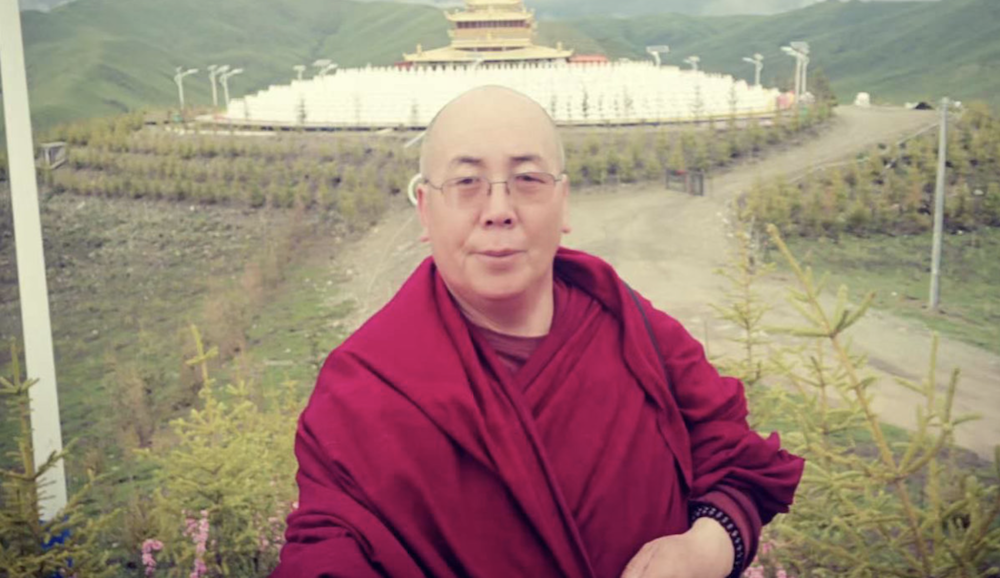Tenzin Nyidon
DHARAMSHALA, Sept. 24: The Metropolitan Museum of Art in New York has recently unveiled a remarkable installation titled “Biography of a Thought”, featuring an intricate series of Tibetan mandala inspired paintings by renowned Tibetan artist Tenzing Rigdol. Based between Nepal and New York, Rigdol’s work reflects a deep engagement with Tibetan spiritual traditions, reinterpreted through his lens.
Dissecting his thoughts, Rigdol shared that the conceptualisation and creation of the mandalas took a span of five years. He dedicated two years to the work in New York and an additional three years in Kathmandu, Nepal, with the support of his team. The “Biography of a Thought” mandalas delve into the complex layers of human consciousness. Drawing inspiration from the ancient tradition of sand mandalas, Rigdol has reimagined this sacred art form using modern materials, with a particular emphasis on at least 50 shades of blue, which serves as the dominant colour throughout the installation. The use of blue, symbolic of both the sky and ocean, evoking the vastness and depth of thought.
The installation is structured into two halves, with four large paintings adorning the walls. The first panel introduces the fundamental principles of tantra, which are central to Tibetan Buddhism. At the core of the exhibit is a striking visual element— the artist’s own head wrapped in cloth, an image that recurs throughout Rigdol’s body of work.

“In most of my work, I have this one element that is repeated. I am in the painting with my head wrapped around. In all my paintings, it mostly symbolises not that I celebrate ignorance, but I am saying I am ignorant. I don’t know everything, but the little that I know, I want to share with you,” Rigdol explained in an interview with the MET.
Rigdol’s philosophical exploration is also reflected in the acronym of the exhibit’s title, ‘Biography of a Thought’, which spells out BOAT. He elaborated on the significance of this in one of the paintings, “In the first painting, you have myself thrown into the world, ready to learn, ready to unwrap a little bit more. When I was young, I studied in computer class, and they used to say, G.I.G.O.—garbage in, garbage out. I thought it was talking about karma. The first panel is really about how we throw garbage and everything into the ocean, and you can also see the karma—where everything you plant comes back,” he said.
The second panel delves into the idea of how an unstable mind can create an unstable world, highlighting how human conflicts arise. It referenced significant historical tragedies like the bombings of Hiroshima and Nagasaki. Another powerful image in the panel is the Twin Towers, evoking memories of 9/11. Rigdol explained that during the creation process, the George Floyd incident occurred, stirring widespread anger and frustration. The artwork also addressed the heart-breaking issue of gun violence, particularly involving children, a pressing concern in America.
Rigdol connected these events to a deeper tantric philosophy. “In Tantra, you don’t revisit the past to inherit hatred or to worsen things. You only visit the past to inherit its wisdom,” he noted, emphasising the importance of learning from history without being consumed by it.
In the third panel, the focus shifts toward finding stability. Rigdol opened with a nod to Picasso’s Les Demoiselles d’Avignon, portraying five women. At the center of the piece, he placed an image of Ardhanari—a half-male, half-female figure from Sanskrit tradition. This duality, he explained, symbolises the balance of masculine and feminine energies that make up human existence. “Tantra is really about finding commonality—what is unique in me, but also in you. We are unique, yet the same,” he noted.
The contemporary Tibetan artist also referenced modern whistle-blowers like Haugen, Manning, Snowden, and Julian Assange—individuals exposing hidden truths. “These people are warning us, yet our attention is being trained out of us by technologies like the iPhone,” he reflected, suggesting that society is losing focus. This concept sets the stage for the fourth panel. The imagery of multiple hands mimics the iconography of a deity, with the American Sign Language phrase “Up is down” appearing in the palms. Rigdol used this metaphor to propose a radical idea: “Wouldn’t it be nice if our brain functioned like a stomach? We would only think enough. Once the stomach is full, we vomit. Now is the time to limit your thoughts.”
The fourth panel brings the viewer to a place of stillness and reflection. “Now, just sit,” Rigdol suggested. “Calm yourself, and observe—what remains, the residue, is likely who you truly are.” He played with the metaphor of clouds representing thoughts. “Some clouds are playful, some are angry, while others are simply relaxed,” he explained. Gradually, in the fourth panel, these clouds of thought begin to settle, revealing the sky as a symbol of awareness. “The goal,” he said, “is to have fewer thoughts and more love.”
At the heart of this panel is the idea of interdependence—the notion that, in the end, we are all connected. Rigdol’s centrepiece emphasised that individual existence is the interconnectedness of actions and their consequences.









